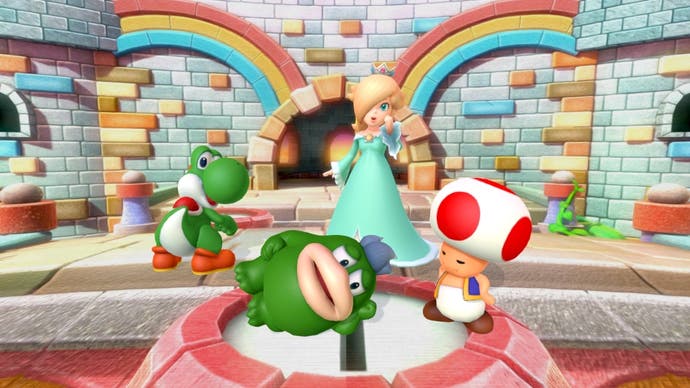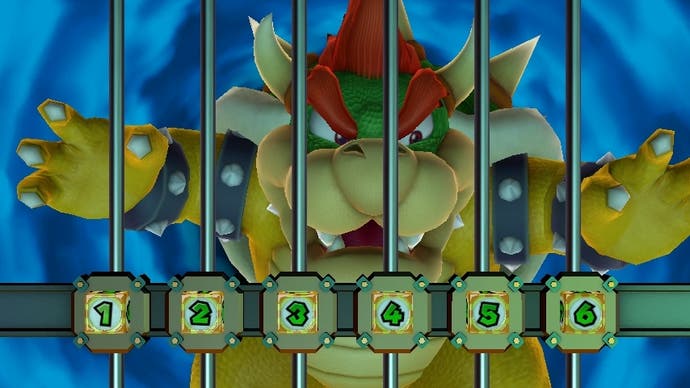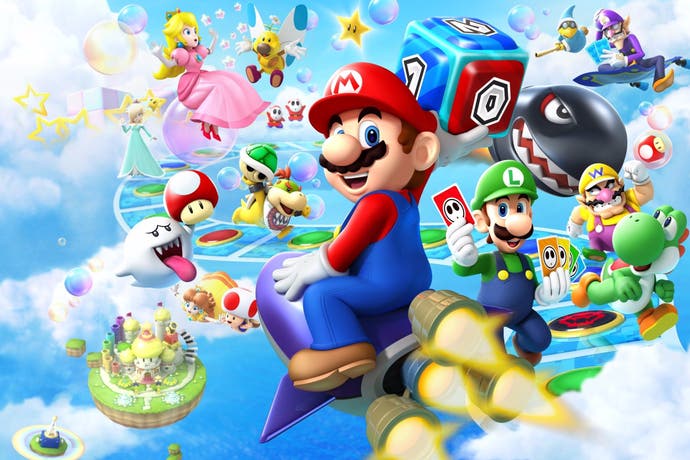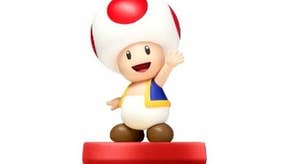Mario Party 10 review
Toy soirée.
For a game that has no pressing reason to be, Mario Party 10 makes a decent fist of justifying its existence. It still suffers from many of the same problems as its predecessors - repetition, inconsistency, outrageously underhand CPU opponents - but developer Nd Cube has at least attempted to inject some fresh ideas into a series that, as recently as two games ago, was beginning to feel well past its sell-by date.
There are three distinct game modes here, one of which is instantly familiar. The traditional Mario Party was shaken up a little in the last instalment by changing the way players move around the board: all four competitors travel in the same vehicle, but only the player in the driving seat benefits or suffers from the result of their dice roll.
For my money, it's a neat idea - it keeps everyone closer together, ensuring no one's left lagging behind by throwing a succession of ones and twos - but it seemingly divided fans of the series last time out, and it's unlikely its implementation here will change anyone's mind.
Indeed, the flow of the game is damn near identical. Each game sees you travel around one of five themed boards, occasionally competing in mini-games in which you earn mini-stars, which are totted up when you defeat the boss at the end - with randomly-chosen bonuses awarded for specific accomplishments - at which point a winner is declared. Once collected, special dice can be deployed tactically to give you a better chance of landing on (or avoiding) particular spaces, but all players are beholden to the caprice of the roll.

Each board has its own individual gimmick, of which the four-stage Airship Central is the best. The first few turns take place on a series of hovering ships which swap places after each turn, some containing more favourable spaces than others. Then it's a stretch through the clouds dodging missiles fired by Bowser, hovering nearby. During the third part, you'll use cannons to shoot his airship down. Finally, as per tradition, the home straight sees the player in last place given a helping hand: a slow dice block allows them to land where they like, and they get their pick of the mini-games.
Almost all the better examples of these are the games where it's every plumber, princess or sentient toadstool for themselves; the one-vs-three and two-on-two variants are both fewer in number and comparatively dull. Some of the finest offer loose riffs on Mario platformers: Snake Block Party is like a miniature top-down 3D World stage, while Peepa Panic sees you race through a ghostly gauntlet, and Spiked Ball Scramble asks you to negotiate thin walkways while avoiding being knocked into the lava at either side.
Others bring a bracing dose of U-rated violence. Bouncy Brawl sees you hammer a button to become a tiny whirlwind, bouncing rivals off a floating platform without making yourself dizzy. The brilliant Flash Forward, meanwhile, sees all four players jostling for position in front of a camera, pushing and ground-pounding one another for a spot on a podium to pose when the flash goes off. It's all you can do not to respond in kind - it's one of a handful of games likely to prompt the odd playful jab in the ribs or a not-so-gentle shoulder nudge.
Motion-based inputs are employed prudently. Tilt controls contribute to the knockabout chaos of Blooper Blast-Off, a crowded underwater race through a volley of Banzai Bills, while flicking the remote to leap incoming snowballs in Ice Slide You Slide makes perfect sense given the slippery surface.

Amiibo implementation, meanwhile, is decidedly mixed. On the one hand, they get a complete mode to themselves; on the other, the boards are far less dynamic. In fact, it's the same board repurposed slightly depending on which compatible figures you own - they look different, but are otherwise functionally similar. Though you'll need at least one toy to unlock the mode, you're not missing out by not owning more, as you can collect tokens that allow you to change any of the four quadrants of the board. Essentially, you're getting the same experience as someone who collects the set; having all the characters in plastic form merely allows you quicker and more flexible access to that content.
Still, there's something pleasurably tactile about the way they're rendered in-game as physical counters, hopping around the board as if held by an invisible hand. And in a delightful touch, perhaps inspired by the superb 3DS RPG Crimson Shroud, they can be spun or toppled with the dice; likewise, the cardboard cut-outs that represent every non-Amiibo character. You can even press the figure against the GamePad to shake the die and lift it to roll, though if that sounds like a gimmick too far, waiting a couple of seconds and tapping A achieves the same result.
It's a rare visual flourish in a game that's decidedly lower tech than the likes of Smash Bros. and Mario Kart, though the Mushroom Kingdom settings still look crisp and lovely in HD, and there's real character in the animation, particularly the post-game poses. Wario and Waluigi are a joy - the most ungracious winners by far and terrible losers, the latter throwing the kind of tantrum you'd normally associate with a Premier League footballer disputing a refereeing decision. And there's both pathos and comedy in Luigi's third-place expression - he looks for all the world like a man in the middle of an existential crisis.

As with Nd Cube's Wii Party U, the poor GamePad is given short shrift for the most part, but here it has an unlikely champion. Bowser is the undoubted star of the show, getting a set of mini-games all to himself, and his own game mode which reminds us what a great idea asymmetric multiplayer can be when done right. Three of the boards featured in Mario Party mode host a five-player game that sees Bowser pursue a quartet of players, waiting for them to finish a round before rolling four dice to catch up. When he does, it's up to the GamePad player to steal hearts from the other players by damaging them in mini-games, spinning and stopping an electrified hamster wheel with the stylus, or using the GamePad's triggers as pinball flippers to direct two giant spiked balls at the terrified foursome. Remove all a player's hearts and they're out of the game, which makes the rest of the group easier to catch in subsequent turns - though they can still take part by passing special dice to their team-mates to even the odds.
It's a mode full of small, inventive ideas. While waiting for your turn, you can idly roll the dice in Bowser's scaly paw by tilting the GamePad, while forks in the road invite you to draw or stamp on the screen to trick the current driver into picking the more hazardous of two obscured routes. A mini-game that asks you to blow into the GamePad mic to breathe flames at Mario and co. is the most obvious misstep, though in your light-headed state immediately afterwards you might well be convinced that a first-person Bowser game should be Nintendo's immediate priority. Playing the bad guy is a lot of fun, and it's a pity only a mere ten mini-games take advantage of a winning concept.
Such is the nature of a game that's trying to offer something for everyone; invariably, there's never going to be quite enough of the stuff you like. And perhaps Mario Party's desire to be truly inclusive will always hold it back from being a classic. This is, at least, in the upper echelons of the series: a little short of the Hudson Soft heyday, maybe, but better than every entry since the fifth, and certainly superior to the anaemic eighth entry and the pointless handheld versions. Wii U owners already have deeper and more substantial multiplayer options, but few - if any - of them are quite so welcoming to all.










